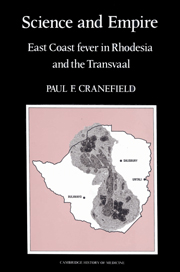Book contents
- Frontmatter
- Contents
- List of illustrations
- Preface
- Acknowledgments
- 1 Prologue
- 2 The places and the players
- 3 A new disease?
- 4 The search for an expert
- 5 Robert Koch in Bulawayo
- 6 Joseph Chamberlain
- 7 Arnold Theiler, Charles Lounsbury and Duncan Hutcheon
- 8 The fight against East Coast fever
- 9 The African-owned cattle in Rhodesia
- 10 Two more parasites and another new disease
- 11 What is East Coast fever?
- 12 Epilogue
- Notes and references
- Index
11 - What is East Coast fever?
Published online by Cambridge University Press: 19 January 2010
- Frontmatter
- Contents
- List of illustrations
- Preface
- Acknowledgments
- 1 Prologue
- 2 The places and the players
- 3 A new disease?
- 4 The search for an expert
- 5 Robert Koch in Bulawayo
- 6 Joseph Chamberlain
- 7 Arnold Theiler, Charles Lounsbury and Duncan Hutcheon
- 8 The fight against East Coast fever
- 9 The African-owned cattle in Rhodesia
- 10 Two more parasites and another new disease
- 11 What is East Coast fever?
- 12 Epilogue
- Notes and references
- Index
Summary
The study of East Coast fever and of other diseases caused by theilerial parasites has continued without interruption since 1910 and is very active today. I have touched very briefly on immunity and the efforts to produce a vaccine in chapter 7. Other areas of research have involved the study of the life cycle of the parasite in the tick and in the infected animal, the cultivation of the parasite in vitro, the taxonomic classification of the parasite and the study of the way in which the parasite actually causes the disease. Each of these studies has overlapped with and involved the others but I have separated from them, somewhat artificially, a series of results that has led to the present-day view of how Theileria parva kills an infected animal.
Since the material reviewed in this chapter is unavoidably technical, for the reader who does not care to struggle through it, here is the bottom line: cattle suffering from East Coast fever develop what amounts to an acute leukemia combined with tumors called lymphomas and, because of the destruction of the normal lymphocytes, develop immune deficiency and become susceptible to bacterial infection. Although I must use many technical terms, I often try to define them; even when I do not I hope that the gist of the argument can be grasped anyway.
- Type
- Chapter
- Information
- Science and EmpireEast Coast Fever in Rhodesia and the Transvaal, pp. 258 - 276Publisher: Cambridge University PressPrint publication year: 1991



